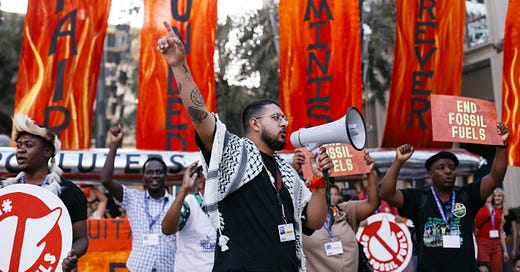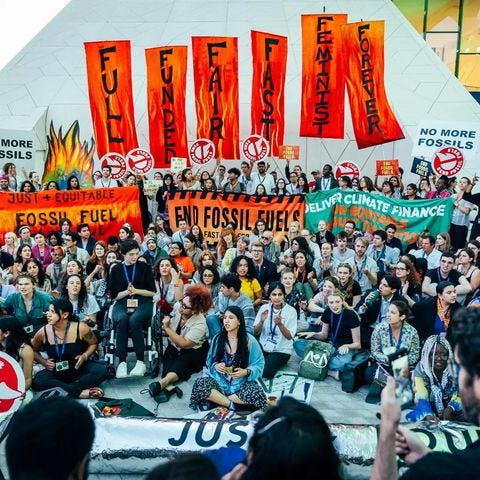COP28 was a let-down. So what?
Let's talk about how many things are going well in the rest of the world. Also, a guest piece on Europe's wild rivers.
I’m the last person in the office and I will be tomorrow as well.
Went to put the kettle on. So tired I wanted to sit down on the floor while the kettle boiled. But working professionals don’t do that (in public).
But in the haze I feel clear-headed.
I’ve been covering COP28 and EU negotiations for The Green Fix and two NGOs. Where most people limit their time scrolling the apocalypse on Twitter and Instagram, I have literally made it my job.
I chose this, I tell myself as daylight fades outside and I keep sitting here, chained to my laptop waiting for the final negotiation outcomes after weeks of early starts and late finishes.
I stopped replying to messages from friends. Can’t think over the alarm bells in my head. Low on fuel. Stop burning it.
There’s an emergency, I want to tell everyone. We’re holding a climate conference to rescue a burning planet, and instead of firefighters, we sent fossil fuel lobbyists.
Coworkers drop by my desk as they pack up to leave. Doesn’t look too good over in Dubai does it?
At COP26 I gave up on UN negotiations as a place where change happens. I think that was my mistake. To see these processes as decisive moments at all.
We speak of the outrage, the hypocrisy, the greenwashing. We speak about the state of the world. The sheer state of it. Just look at the news.
I get it. Two years ago I could barely stand to keep reading about global issues.
But why is there so much news about greenwashing and closed-door deals with the fossil fuel industry?
Because the things that hurt us hope to remain secret and unacknowledged. Addiction, bad habits and fossil fuel business deals, they try to remain in the shadows.
But darkness vanishes under the spotlight. Everywhere the lobbyists try to hide, we follow. Everywhere they go, there we are.
That’s why we plaster news story after news story about it. To say We see you. You cannot hide.
Of course COP28 is underwhelming. Of course this work is overwhelming. I am plagued by the feeling that I’m only grasping a small thread of what’s happening. That everything seems to be happening where I am not and all issues I focus on are missing the point.
COP28 ‘failed.’ What did we expect? World leaders are the global minority.
Fossil fuel company executives are outnumbered by people working to improve the world. Their power is unbalanced, yes, but we know how to tip the scales.
The actions of a global minority do not reflect the state of society. We do.
And the majority of the world is trying damn hard. Protesting in the streets and cutting up pizza boxes to separate recycling and googling which charities are the real deal and tweeting and joining NGOs and picking up litter in the street.

The noise is deafening. Not the dying wails of fossil fuel industries, but the cacophony of solutions and action and downright cool things happening around the world.
It’s OK to feel tired. I think I could sleep for a week. It takes energy to keep up this momentum. We have to use it wisely - I should know, I never have and my inability to allocate my energy wisely sabotages my work more than any corporate lobbyist.
As COP28 trundles along to its inevitable anticlimax, there will be outrage, as there should be. But the outrage should not displace your belief that there is a point in trying to fix the injustices of the world.
I’ll probably never go to Dubai. Why should the decisions made by men I’ve never met in a country I’ve never seen, dictate my worldview? What decision could they possibly make that would make it not worth our time to keep trying to do something good today, tomorrow, and every day after?
Anyway. I should reply to the messages stacking up. Then go to sleep - and when I wake up, there will be a fresh world of noise and opportunity.

Image credit in banner image: @Bianka Csenki / Artivist Network
What’s Going On?
The COP28 Summary
What they decided
Commitments to triple renewable energy and double energy efficiency.
Invitation to ‘transition away’ from fossil fuels but no explicit phase-out.
Loophole language risks reliance on carbon capture & unproven technologies.
Global targets on adaptation made - but without implementation mechanisms.
Adoption of a Loss and Damage Fund to help climate-vulnerable nations.
Let’s also shout out the big businesses trying to influence behind the scenes:
Record numbers of fossil fuel lobbyists got admitted to the climate talks.
Also a record number of lobbyists from high-emitting industrial agriculture.
More than 160 representatives with climate-denying track records got access.
Here’s the army of PR agencies that the oil baron host of COP28 used to greenwash himself.
The oil industry also tried to push for a ‘phase out’ based on unproven carbon capture and storage technologies (that they would own, of course).
There’s even 7000 bots on Twitter greenwashing the UAE COP28 presidency.
Literally everywhere else except Dubai
How coal giant Colombia is trying to wean its country off fossil fuels.
Related: Sierra Leone secures $52 million for groundbreaking solar power initiative.Big Oil given direct influence over UK university courses.
Related: French oil giant TotalEnergies linked to bullying and intimidation of families in path of its proposed oil pipeline.Seven of the world’s “most trusted” media companies produce and promote content touting the key talking points of oil and gas.
Related: Leaks reveal how American consultancy McKinsey drives African climate agenda.Are young people poised to slam the brake on endless economic growth?
Useful: What is degrowth?UN sets out roadmap to combat global hunger and limit global heating.
Related: What would it take to end the meat culture wars?
If you’d like to support The Green Fix, please consider tipping us a virtual coffee.
Focus On… Saving Europe’s Wild Rivers
Megan Claire Routbort, climate storyteller and co-founder of The Green Journey, shares her experience bikepacking through Albania to learn about the benefits of fighting for Europe’s wild waterways.
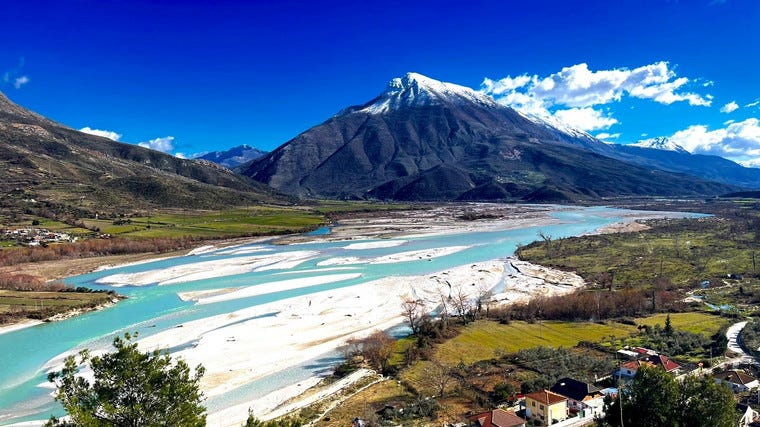
My bike rattles and clangs as I battle my way up the gravelly hills. I’m pouring buckets of sweat – partially induced by the effort of the climb, but also because it’s the hottest summer Europe has ever seen.
I’m heading towards Kutë, a village in Southwestern Albania, to meet with the brave local activists who fought tooth and nail to defend the last free-flowing river in Europe from a dam that would have drowned their home.
In March 2023, environmentalists across the globe celebrated the declaration of the Vjosa Wild River National Park in Albania, the first of its kind in the European continent.
But what exactly is a wild river, and why was this an important milestone (besides, of course, the fact that Leonardo DiCaprio posted about it on Instagram)?
The Blue Heart of Europe
Flowing from one iconic capital to the next, Europe’s rivers have captured the imaginations of countless generations of locals and travelers alike.
Though you wouldn’t know it by looking at them — Europe’s rivers are among the most domesticated in the world. They’ve been subjected to centuries of human domination and engineering that has literally reshaped their flows and ecosystems. Dams, barriers and weirs have fueled a hydropower boom, fed fisheries, and filled agricultural reservoirs.
But the proliferation of blockages has led to harmful side effects, including the impediment of water quality and the destruction of wildlife habitats.
Wait, I thought that dams were a good thing!
Well, everything is good in moderation.
As a low-carbon electricity source, hydropower is generally regarded as the most mature, reliable and cost effective technology available in the world today. In many markets, it’s the lowest-cost source of electricity, period.
But, problems arise when damming is done indiscriminately. Most dams have a design life of 50-100 years, and the density of barriers that are redundant or in disrepair are contributing to poorer river quality and a catastrophic decline in Europe’s freshwater species.
Today, there are over one million barriers in Europe’s waterways, and research from Dam Removal Europe estimates that 150,000 of these are obsolete and at risk of collapse.
A climate and nature-safe future means thinking more carefully about where and why we dam rivers.
The Vjosa Victory
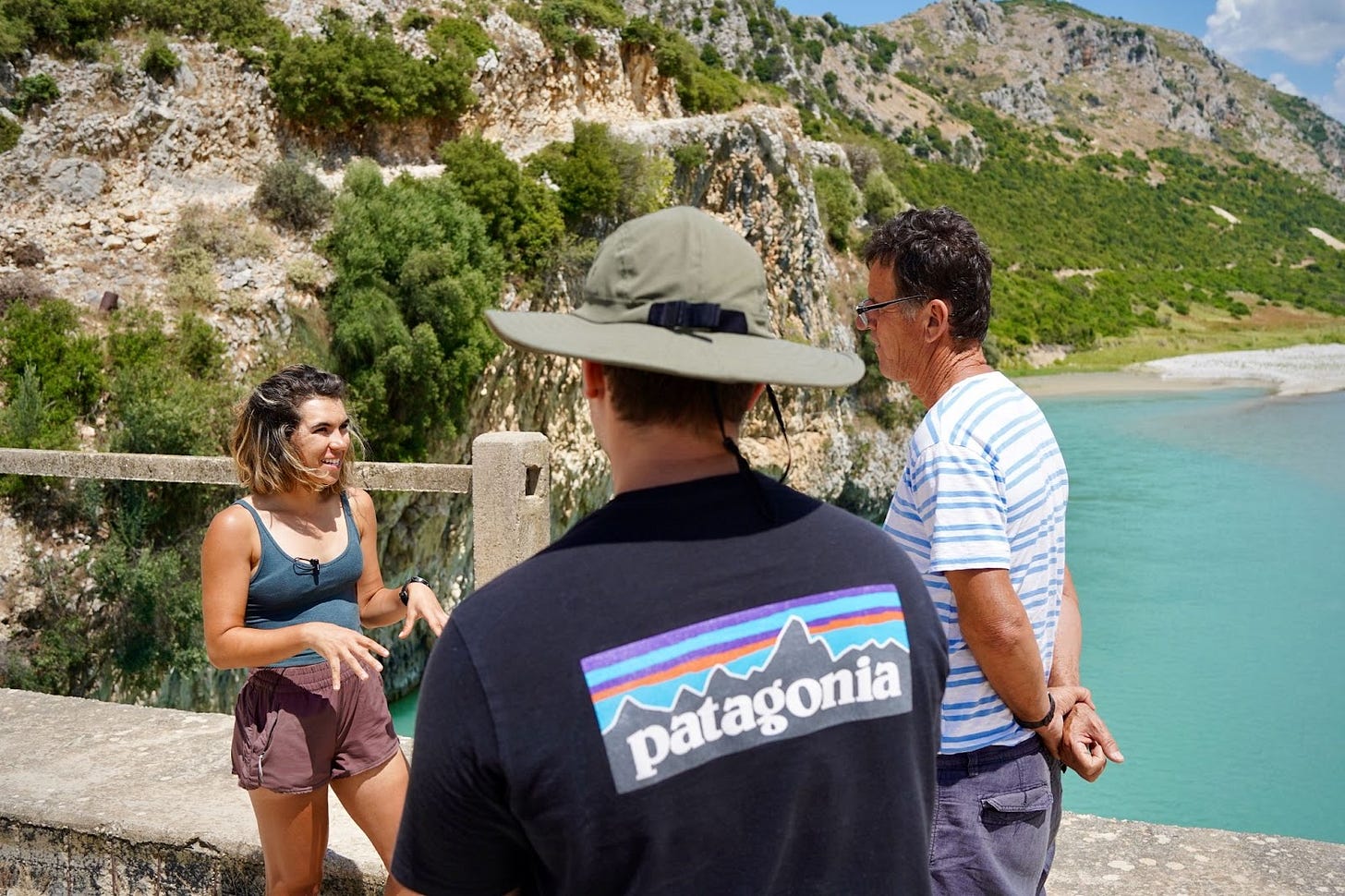
I biked to Albania to visit the Vjosa River because this wild jewel is the best example we have of a wild river – and the movement to save it – in Europe. Arising in the mountains of Greece and flowing 270 km northwest through Albania before emptying into the Adriatic, the Vjosa avoided damming for centuries due to the region’s agricultural and ecological value.
The Vjosa is the perfect example of a river that should NOT be dammed; for one, it’s a sediment-bearing river, meaning the consequences of an ill-placed barrier are particularly consequential: erosion, degradation of downstream water quality, and silt buildup.
Additionally, indiscriminate damming is a critical environmental justice issue. Damming the Vjosa would displace local Albanians who have called the watershed home for centuries for the benefit of a foreign hydropower developer. And some of the damming’s consequences, like the flooding of ancestral grave sites, would be impossible to compensate for.
So what can we do to protect Europe’s rivers?
The Vjosa is an incredible case study in grassroots climate activism going global to save an already-pristine ecosystem – but what can we do to set more of Europe’s rivers free?
Enter Dam Removal Europe. A joint project between multiple NGO partners including The Nature Conservancy, The World Wildlife Fund, The World Fish Migration Foundation, and others, whose mission is “to restore rivers that have high natural or cultural importance”.
Last year, the organisation contributed to the record-breaking removal of 325+ barriers across the continent. And, while we’re still waiting for 2023 numbers to be counted, the initiative’s dynamic map shows a promising trajectory, with each dam removal bringing the European continent closer to having more free-flowing rivers!
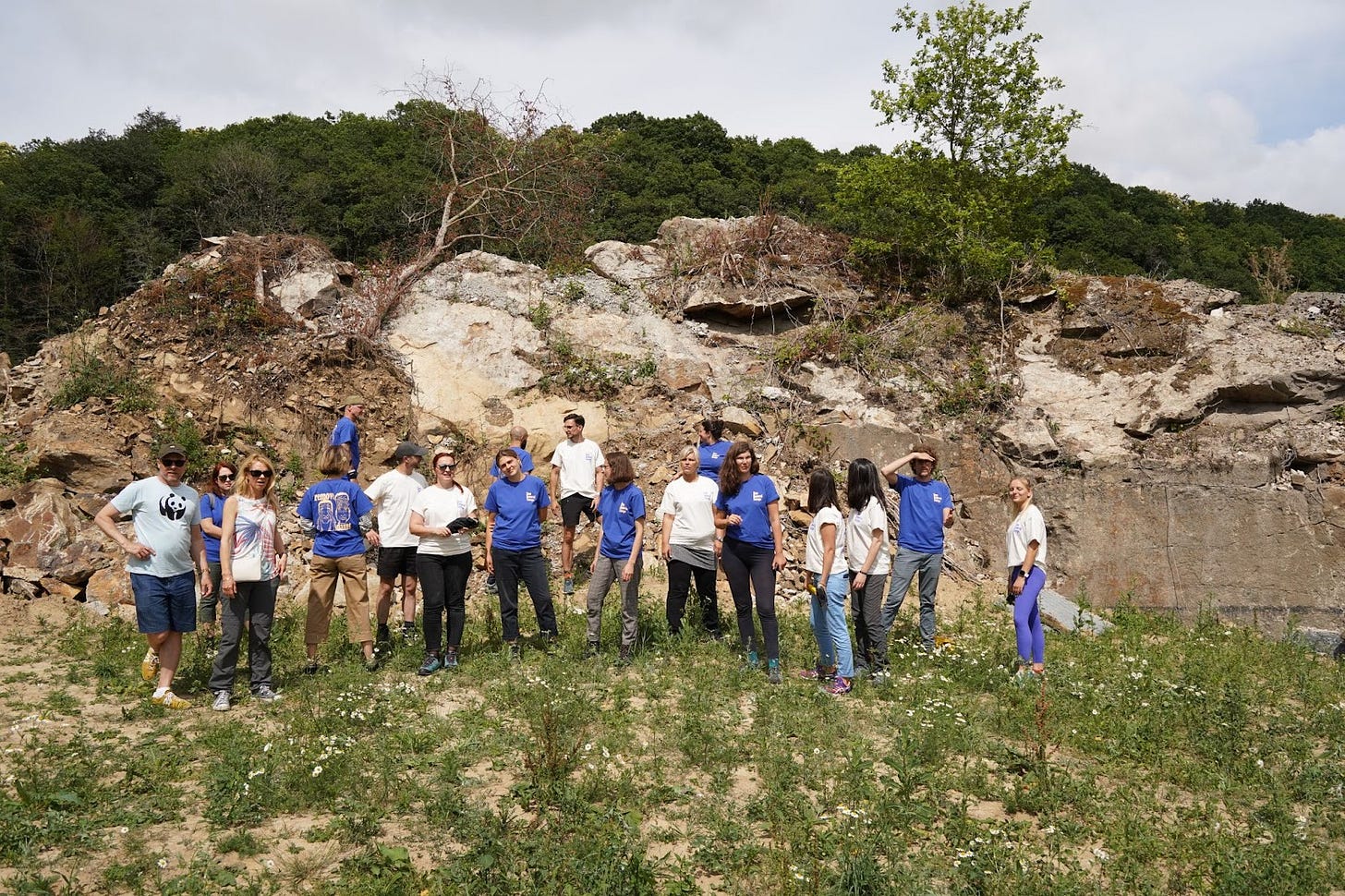
At a conference this summer I spoke to Pao Fernandez Garrido, a dam removal specialist with World Fish Migration Foundation, about the coalition’s mission.
“The critical thing to understand about dam removal is that it’s not some radical tradeoff between human interests and nature,” she said. “We’ve set out to remove dams that are obsolete, that are no longer serving a purpose. By restoring waterways, we’re helping people and the planet simultaneously”.
If you want to get involved…
If you’re inspired to ‘go wild’ with a local waterway:
Watch a movie: Dam Removal Europe has filmed an inspiring documentary – it’s totally free to watch! Screen #Dambusters: The Start of the Riverlution on WaterBear Network! Or if you’re looking for a shorter screen, Together We Stand highlights the efforts of local people in Bosnia and Herzegovina to fight against corrupt hydropower development.
Find a barrier near you: With over 150,000 obsolete dams across Europe, chances are there’s a dam, barrier, or weir near you that could stand to come down. The Nature Conservancy developed this online toolkit to provide an introduction to dam removal as a tool for river restoration.
You can follow the low-carbon travels of The Green Journey on their Substack.
So Now What Do I Do?
LEARN SOMETHING
Join: How do you keep working on global issues without burning out? An online workshop by Reconsidered on 14 December. Pay-as-you-feel.
Read: From Uganda to COP: An activist’s fight for climate justice.
Listen: Celebrating indigenous women leadership, a podcast by Black Earth.
DO SOMETHING
The Global Citizen Award closes submissions on the 15th December!
Young people working in sustainable project management can apply for this cool holistic residential training in Slovenia by the 10th January.
CHANGE THE SYSTEM
Purpose-driven start-ups can apply for the Impact Shakers Accelerator by the 22nd December.
The Summit of the Future has an open call for written inputs for the preparation of the zero draft of the Pact for the Future. Find out more here.
Sign the petition to make Erasmus more accessible for low-income students.
By the way…
The Green Fix is now offering low-cost sponsored slots on the newsletter. Book your slot by emailing wearethegreenfix@gmail.com.
Stay in the loop
You can follow the Green Fix on Twitter @TheGreenFix, Instagram @thegreenfix_ and LinkedIn. You can also connect with Cass Hebron (Editor) on Instagram @coffee_and_casstaways, Twitter @casstaways and LinkedIn Cass J Hebron.


